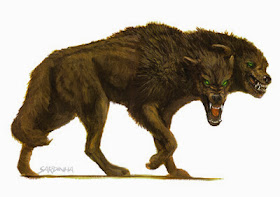 A gaunt figure clad in gray-hued jester's motley comes capering around the corner. Its feet move silently on the stones, and it grips a scepter with a doll's head atop it in one hand.
A gaunt figure clad in gray-hued jester's motley comes capering around the corner. Its feet move silently on the stones, and it grips a scepter with a doll's head atop it in one hand.Source: Heroes of Horror (Dungeons & Dragons 3.5)
Otherworldly fey drawn to humanoid emotion. The Gray Jester drains joy from those around it. Appearing as mimes, clowns, or jesters they feast on positive emotions such as laughter, joy, happiness, etc. The Gray Jester has the ability to cause laughter through it's fey magic while at the same time feeding upon those emotions.
Once all sign of happiness is extinguished their victim become the Bleak Ones. They lose all self will and the capacity to feel positive emotions. The Bleak Ones become followers and soldiers for the Gray Jester.

Combat: The Gray Jester is a challenge rating of 4. It has damage reduction 10/cold iron and spell resistance 18. It has the ability to touch a subject with it's hand or scepter to cause laughter like Tasha's Hideous Laughter spell. If the subject is under the laughter spell or feel joy from another source the Gray Jester can feed upon those emotions. While feeding the victim takes 1d4 points of charisma drain. The Gray Jester can drain up to three victims at a time.
Once a Gray Jester has drained it's victim or victims it is at it's weakest. It's damage reduction and spell resistance is reduced. Those victims whose charisma is drained to zero become Bleaks Ones. Emotionally devoid followers of the Gray Jester
 Inspiration: Who doesn't want a demented clown tormenting the local village? I like the concept of the group entering a relatively abandoned village. A group of children are all that is left of the residents. They have been drained of their emotions and have become Bleak Ones. Their sole purpose is to lure victim to the Gray Jester tea party.
Inspiration: Who doesn't want a demented clown tormenting the local village? I like the concept of the group entering a relatively abandoned village. A group of children are all that is left of the residents. They have been drained of their emotions and have become Bleak Ones. Their sole purpose is to lure victim to the Gray Jester tea party.You could also have the carnival come to town. The travelling freak show sole purpose to lure victims to the Gray Jester so can feast upon their raw emotions,
.jpg)








.jpg)





